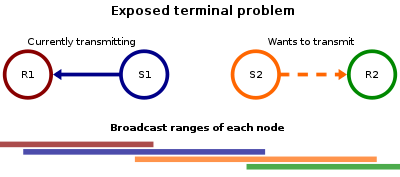
Exposed terminal problem
Encyclopedia

IEEE 802.11 RTS/CTS
IEEE 802.11 RTS/CTS
RTS/CTS is the optional mechanism used by the 802.11 wireless networking protocol to reduce frame collisions introduced by the hidden node problem...
mechanism helps to solve this problem only if the nodes are synchronized and packet sizes and data rates are the same for both the transmitting nodes. When a node hears an RTS from a neighboring node, but not the corresponding CTS, that node can deduce that it is an exposed node and is permitted to transmit to other neighboring nodes.
If the nodes are not synchronised (or if the packet sizes are different or the data rates are different) the problem may occur that the sender will not hear the CTS or the ACK during the transmission of data of the second sender.

